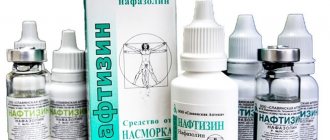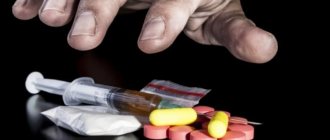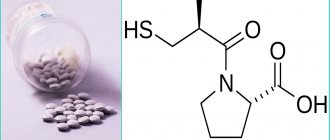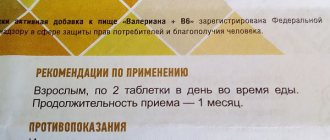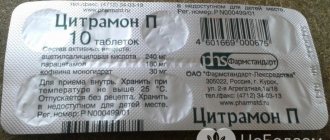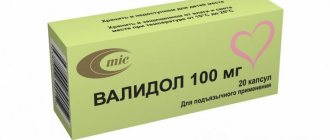The drug is an analgesic with a combined effect, an antispasmodic analgesic. Relieves pain symptoms due to spasms of organs with smooth muscles.
The main active ingredient of the drug is dicycloverine, it also contains paracetamol. When these two substances are combined, the analgesic effect increases several times and the time for the onset of the effects of the tablets decreases.
Release form
The medicine is available in the form of tablets, in paper packs of 10, 20, 100 units.
The drug Trigan D consists of:
Paracetamol (500 mg) and Dicycloverine (20 mg).
The medicine is produced in India, and the owner is listed as Cadila Pharmaceuticals in the registration documents.
The drug is used to relieve pain symptoms in the epigastric region of various pathological nature:
- Colic in the liver, intestines, kidneys;
- Functional bowel disorder;
- Painful menstruation;
- Neurological seizures;
- Inflammation of the sciatic nerve;
- Muscle pain of various origins;
- Painful symptoms due to inflammation of the joints.
In case of colds, it is used as an antipyretic medication, effective due to the paracetamol in its composition.
For patients who have diseases such as: impaired liver function, kidney function, the presence of tachycardia, increased hormonal activity, high blood pressure, hernia of the stomach, esophagus, intestines, heart disease, use Trigan D with caution.
Features of Trigan D
The effect of Trigan D is due to its composition, which combines components from two groups - NSAIDs and antispasmodics.
Penetrating into the body, the drug is quickly absorbed into the systemic circulation from the lumen of the small intestine.
The active components are metabolized by hepatocytes in the liver with the formation of inactive breakdown products that are excreted from the body through the kidneys in the urine.
Dicyclomine is the active ingredient of the drug Trigan D
When using the drug, some features should be taken into account: the joint use of the drug and alcoholic beverages is prohibited, especially for persons suffering from alcoholism, liver and kidney diseases in the acute stage.
The drug affects areas of brain activity and affects the performance of the nervous system. It is not recommended to take Trigan D while driving vehicles or engaging in potentially hazardous activities.
Composition of the drug
Trigan D is a combination product that is produced on the basis of two main active components:
- dicycloverine hydrochloride (dicyclomine) - has antispasmodic, anticholinergic and myotropic effects, promotes relaxation of smooth muscles, thereby reducing pain; used to treat intestinal pathologies, affects the muscles of the bladder, preventing spontaneous urination;
- paracetamol is a non-narcotic analgesic and has a mild anti-inflammatory effect.
The drug contains excipients: cellulose, polyvinylpyrrolidone, silicon dioxide (E551), magnesium salt and stearic acid (E 572), starch.
Instructions for use for medical purposes
According to the instructions for use, the drug Trigan D is used as follows:
- The tablets are taken orally, 30-40 minutes after a meal, without chewing, with a sufficient amount of water.
- For children over 15 years of age and adults, the recommended dose is 1 tablet in the morning and evening; if necessary, it can be taken up to 3 times a day.
- The maximum number of tablets at a time is no more than two, the daily dose is no more than four tablets.
- For pain, the drug is continued for five days, and as an antipyretic – up to three.
- The decision on the need to extend the course of therapy is made by the attending physician.
Trigun D abuse
Long-term, uncontrolled use of the drug Trigan D leads to the development of negative consequences such as discomfort and pain, which intensify with increasing dosage.
As a result, the person does not understand what caused the poor health and, in trying to figure it out, misses the presence of a formed psychological dependence.
Trigan D is a popular drug among teenagers due to its availability
More often, uncontrolled medication use occurs in adolescence; replacing drugs with an available drug, increasing the dosage, adolescents often risk causing an overdose of the drug.
This condition is accompanied by a severe symptomatic complex and requires emergency medical care.
Overdose symptoms
An overdose of Trigan D causes a psychoactive effect and the development of a clinical picture:
- dryness occurs in the oral cavity;
- chills and fever appear;
- surrounding objects seem blurry;
- a “glassy” look appears;
- loss of appetite, nausea, and in some cases vomiting;
- movement coordination disorder;
- dizziness;
- the frequency and rhythm of heart contractions are disturbed (bradycardia is replaced by tachycardia);
- pain in the upper abdomen;
- hallucinations occur;
- initially the person is excited and euphoric, but soon apathy and drowsiness develop;
- muscle weakness, possible convulsions, paresis or paralysis of the upper and lower extremities;
- respiratory dysfunction;
- loses memory for some events;
- the person behaves inappropriately;
- in case of an overdose of extremely high doses, necrotizing papillitis occurs (damage to the renal papillae), which provokes the development of a coma, often resulting in the death of the patient.
Read also: Herbal alcoholic drinks
First aid for poisoning
At the first symptoms or suspicion of intentional or accidental intake of high doses of the drug, you should immediately call an ambulance.
If you suspect an overdose of Trigan D, you must call an ambulance
You can independently help a person in the presence of consciousness by taking the following measures:
- To provoke vomiting - it is necessary to give the victim 1-1.5 liters of water to drink, then press on the root of the tongue with a spoon and induce vomiting. The steps are repeated until the vomit consists of clean water.
- Use any available sorbent - activated carbon, Smecta, Atoxyl or any other.
- If a person is unconscious, it is necessary to turn him on his side to prevent vomit from entering the respiratory system.
- Further treatment is carried out in an inpatient department.
- Next, an antidote is introduced - methionine and acetylcysteine.
- Consultation with a psychiatrist is required.
Treatment of addiction to Trigan D
The consequences of an overdose of Trigan D can be fatal, especially for a teenager.
Also, dependence on this medication can lead to the need to use other, illegal drugs.
As you know, drug addiction is a disease accompanied by deterioration in physical health, decreased intellectual thinking and social degradation of the individual.
It is important to detect the problem in a timely manner, understand it and contact a specialist who will help solve this problem. Unfortunately, you cannot cope with drug addiction on your own.
Narcologists will help you cope with the consequences of Trigan D abuse
This condition is treated by narcologists. Initially, treatment is aimed at ridding the patient of physical dependence; for this purpose, drug replacement therapy is carried out.
Next, classes are held with a psychotherapist, during which the specialist tries to convince the patient that drugs are not a panacea for all ills and it is impossible to constantly escape reality by taking these medications.
An important aspect in treatment is the support of loved ones who provide comprehensive assistance and participate in a person’s life.
Therapy is selected individually, depending on the patient’s age, character, psychological problems and other things.
Trigan D, in large doses, acts like a drug, therefore, treatment to overcome addiction is carried out in the same way as drug addiction therapy.
Conclusion
The availability of this medicine encourages teenagers seeking an easy and adult life to try new sensations obtained after taking pills.
We should not forget that a single dose of 4 tablets leads to death. Only by detecting the presence of a problem in a timely manner can a person addicted to drugs be helped.
Video: Video directory of drugs TRIGAN D
Trigan-D is a drug that belongs to the combined group of antispasmodics and analgesics. The main active ingredients of Trigan-D are dicycloverine and paracetamol.
The drug itself is not a drug, however, due to side effects resulting from an overdose, it is popular among drug addicts.
Contraindications
The medicine is produced in the form of tablets. It is sold freely in pharmacies. Sold to adults and children.
Indications for use of the drug, for which the medicine is prescribed:
- Pathology of irritable bowel.
- Colic: renal, hepatic or intestinal disturbances.
- Painful periods in women.
- Pain syndrome manifested in different parts of the body. The medication is used to combat muscle and joint discomfort.
- The need to reduce body temperature. Frequently indicated for colds and flu.
The drug requires prior consultation with a doctor. Perhaps another medicine with less dangerous side effects will help.
A couple of components of Trigan-D are ingredients with a potent effect. After splitting inside, the drug is excreted by the kidneys. At the same time, it is neutralized in the liver. However, there are conditions when the use of the medicine is strictly prohibited. The consequences lead to poor health and death.
Contraindications:
- Kidney failure. Here it becomes unimportant in what form the disease is present. Both the chronic form and the period of exacerbation are dangerous.
- Allergy. If the body does not accept any component of the medication, taking Trigan-D can lead to anaphylactic shock and negative consequences.
- Liver pathology. If there is a malfunction of the organ, incomplete neutralization of the substance occurs.
- For men, prostatitis and prostate adenoma become dangerous diseases.
- It is prohibited to offer to children under the age of 12 years.
- Pathology of the cardiac organ.
- Nonspecific ulcerative colitis makes it impossible to take Trigan-D.
- During pregnancy and breastfeeding.
- The presence of internal bleeding in the digestive tract.
- Pathologies of the stomach associated with a violation of the integrity of the mucous membrane and walls of the organ.
The spectrum of action of Trigan-D is quite wide. It helps to cope with many pains.
- Colic. They come in different origins – hepatic, renal.
- Spasmodic contractions of internal organs. For example, vasospasm.
- Irritable bowel syndrome, when there is a painful contraction of the smooth muscles of the intestine.
- Gynecological diseases. These include: dysmenorrhea (cramping pain in the uterus during menstruation), algodismenorrhea - pain in the uterus with increased nervous excitability.
- Myalgia or muscle soreness.
- Acute respiratory infections, acute respiratory viral infections and other infectious diseases that are manifested by an increase in temperature.
- Before painful diagnostic procedures or in the postoperative period.
- In rheumatological practice to relieve joint pain.
- For radiculitis and other neurological pain.
The drug disrupts the functioning of the endocrine glands, so it is prescribed very carefully at elevated ambient temperatures. Trigan-D reduces sweating, so overheating and heat stroke may occur. The drug is prescribed very carefully to asthmatics, as they are prone to bronchospasm.
Trigan D is available without a prescription. Before use, you must first consult your doctor. What are these pills for? The drug is prescribed to relieve pain in the abdominal area in various pathologies.
Indications for use:
- hepatic, intestinal, renal colic;
- bowel dysfunction;
- pain during menstruation;
- neuralgic spasms;
- inflammation of the sciatic nerve;
- pain in muscles, joints.
During a cold, it is used to reduce fever.
Trigan D should be taken with care by patients with liver disease, kidney disease, tachycardia, hyperthyroidism, cardiac pathologies, persistently high blood pressure, digestive organ hernias, and prostate hypertrophy.
Use of the drug in medicine
Trigan-D is a drug that has a long-lasting antispasmodic, analgesic and sedative effect. Doctors prescribe the drug to their patients for mild, moderate or acute chronic pain of various origins. In particular, resulting from:
- Injury
- Surgical interventions.
- Severe migraines.
- Diseases of the musculoskeletal system (radiculitis, rheumatism, polyarthritis, etc.).
- Toothache.
- Stitching pain and spasms of the intestines, bladder, kidneys or liver.
- Oncological diseases.
In an acceptable dosage, the medicine can relieve pain and spasms. However, when used in large quantities or when combining other drugs and alcohol, Trigan-D causes drug intoxication.
Interaction
The effect of dicycloverine is enhanced by amantadine, class 1 antiarrhythmic drugs, antipsychotics, benzodiazepines, MAO inhibitors, narcotic analgesics, nitrates and nitrites, sympathomimetic drugs, tricyclic antidepressants.
Dicycloverine increases the concentration of digoxin in the blood (due to slower gastric emptying).
Stimulators of microsomal oxidation in the liver (phenytoin, ethanol, barbiturates, rifampicin, phenylbutazone, tricyclic antidepressants) increase the production of hydroxylated active metabolites, which makes it possible to develop severe intoxications with small overdoses of paracetamol.
Adrenergic stimulants, as well as other drugs with anticholinergic effects, increase the risk of side effects.
Microsomal oxidation inhibitors (cimetidine) reduce the risk of hepatotoxicity.
Reduces the effectiveness of uricosuric drugs.
Paracetamol increases the effectiveness of indirect anticoagulants.
The effects of dicycloverine are stimulated by amantadine, antipsychotic drugs, first class antiarrhythmic drugs, benzodiazepines, narcotic painkillers, MAO inhibitors, sympathomimetics, nitrates, nitrites, tricyclic antidepressants.
Dicycloverine increases the level of dioxin in the blood.
Enhancers of microsomal oxidation (ethanol, barbiturates, rifampicin, tricyclic antidepressants) stimulate the synthesis of hydroxylated metabolites in the liver, this can lead to the development of severe intoxication even with mild overdoses of paracetamol.
Inhibitors of microsomal oxidation reduce the possibility of hepatotoxicity.
Adrenergic stimulants and anticholinergic drugs increase the risk of unwanted effects.
Paracetamol activates the effect of indirect anticoagulants.
Use among drug addicts
“Pharmacy drug addiction” began to spread in Russia and other CIS countries in the early 2000s. Some drug addicts who use painkillers in high doses in order to reduce the sensitivity of withdrawal symptoms have noticed that they also cause intoxication. Codeine-containing drugs have become especially popular among heroin addicts.
Among poor and inexperienced drug addicts, who, as a rule, are schoolchildren, combined antispasmodics and analgesics have become popular. In particular, one of these is Trigan-d. Teenagers take 4 or more tablets of the drug, after which unusual intoxication occurs. Due to their low cost and pronounced effect, Trigan D and analogue medications are an alternative to regular cigarettes and alcoholic beverages for schoolchildren.
Signs of intoxication with this drug
Trigan-D and similar analogues have an analgesic effect on the human body. When using the drug above the indicated therapeutic dose, intoxication similar to some types of drugs may occur. Depending on the number of disposable tablets taken, the effect may be as follows:
- 4 tablets cause mild euphoria, relaxation, and a slight double vision.
- With 6-8 tablets taken at a time, the euphoria becomes stronger and relaxed, like when intoxicated with alcohol.
- Taking 8 or more tablets provokes internal tension in a person (although from the outside the addict looks lethargic), auditory and visual hallucinations appear (sometimes very realistic), and “gaps” in memory.
Read also: Tobacco and accessories for rolling papers
Trigan-D causes “intoxication” 30 minutes after administration. When combined with alcohol, the effect intensifies and becomes less predictable. Moreover, such intoxication can last 3 hours.
External signs of drug use are expressed in the following factors:
- Impaired coordination of movement.
- Dilated pupils.
- Lethargy.
- Slurred speech.
- In some cases, paranoia or panic attacks.
The maximum duration of drug intoxication can last up to 3 hours from the moment of administration.
Get a consultation now
Consequences of excessive use of “pharmacy drugs”
Trigan-D is an excellent remedy against severe pain and spasms. However, with constant abuse of the drug, a person may face consequences that include:
- Deterioration or complete loss of vision.
- Liver pathologies.
- Paralysis of limbs.
- Acute renal failure.
- Cardiac arrhythmias.
- The appearance of gastrointestinal bleeding.
- Dry skin.
- Urinary incontinence.
When using Trigan-D with other similar drugs, such as Lyrica, alcohol or marijuana, there is a high likelihood of anaphylactic reactions or falling into a coma. In some rare cases, death is possible.
First aid for drug poisoning
If a person takes too many Trigan-D tablets, he may overdose. It may have the following symptoms:
- Pale skin.
- Cramps.
- Fever.
- Anemia.
- Dilated pupils.
- Vomiting.
- Paranoia.
- Drowsiness.
If it has been established that a person has used Trigan-D and he exhibits one of the above symptoms, he must be provided with first aid. Namely:
- Place a person.
- Perform gastric lavage.
- If it is impossible to perform gastric lavage, induce vomiting.
- Give a person to consume activated carbon at the rate of 1 tablet per 1 kilogram of weight.
Additionally, it is necessary to call doctors or take the person to a hospital, where he will receive more professional assistance and undergo a detoxification procedure.
Many parents do not realize that the painkillers in their children's medicine cabinets can be used as an alternative to drugs to obtain unusual sensations. The main danger of such products as Trigan-D is that they are sold by every pharmacy in any quantity and without a prescription. Due to this, the consuming teenager and his parents have a high probability of encountering an overdose of the drug and subsequent negative consequences.
Video “HOW I HAD A Fatal Overdose (Trigand-D Trip)”
Trigan D is a popular pain reliever available in pharmacies without a prescription. In many ways, the composition of the drug and its availability became the decisive factors for its widespread use not as a medicine, but as a drug, especially among schoolchildren. The narcotic effect of an overdose of Trigan D (among teenagers it is called “trigande” or “trigande”) is euphoria in case of a slight overdose and hallucinations with a large dosage, which are greatly enhanced by drinking alcohol.
Significantly exceeding the recommended dosage instructions has a strong effect on the brain - the range of consequences of taking Trigan D includes mental illness, liver dysfunction, coma and death.
How to get rid of drug addiction
All forms and analogues of Trigan D are drugs that are dangerous due to their imaginary harmlessness. Because of it, psychological dependence on the drug develops, which cannot be completely eliminated by traditional drug courses of treatment designed for 12 or 28 days. The Narconon program is radically different from them. Drug addicts taking Trigan D do not receive drug treatment, which is especially important for psychological dependence. The program includes stages that eliminate the effects of detoxification of the body and return the patient to normal social life:
- non-drug weaning from trigan D. For this, special assist techniques are used;
- “New Life” - with the help of special nutrition, running, visiting a sauna, taking complexes with niacin, vitamins and microelements, the toxic effect caused by taking Trigan D is eliminated;
- “Objective processes” - communication skills are restored, a clear outlook on life is acquired;
- “Overcoming ups and downs in life” - the patient leaves a harmful social circle that leads to a return to addiction;
- “Personal values” - the patient realizes his obligations, stops looking for a return to the past, feels the desire to get Trigun D, buy it;
- “Changing states in life” - the skill of creative problem solving in life is formed.
After completing the last stage of Life Skills, the patient receives the tools that will allow him to quit the drug forever. The technique helps overcome addiction and maintain the positive effect forever.
What is Trigan D - composition of the drug
Trigan D contains two widely used medicinal substances:
- Dicycloverine hydrochloride belongs to the group of antispasmodics that block muscarinic receptors. Due to its anticholinergic activity, it has a relaxing effect on smooth muscles, therefore it relieves intestinal, renal and biliary colic well, relieves pain during menstruation, and is prescribed for spastic constipation, irritable bowel syndrome and pyloric spasm.
- Paracetamol is a non-narcotic antispasmodic with a mild antipyretic effect. Ignoring contraindications when taking it leads to irreversible toxic damage to the liver, kidneys and endocrine glands.
The combination of dicycloverine and paracetamol makes it possible to enhance the effect of the first component of the substance several times.
For most people, if the recommended dosage is increased, an effect appears similar to that of a narcotic, which quickly becomes psychologically addictive. From the point of view of physical effects on the body, Trigan D is even worse than soft drugs like marijuana.
Read also: HIV and alcohol forum
SIGN UP FOR A FREE CONSULTATION
We will help motivate a person so that he has a desire to get rid of addiction. We will give recommendations on how to communicate with a drug addict.
Trigan-D is an industrial pharmacological drug. It is also a drug that slowly “kills” mainly young people. It contains a substance that causes euphoria, and subsequently leads to addiction.
Trigan-D is an antispasmodic, a combination drug that has an analgesic effect on the body. This is due to its anticholinergic activity. It contains several components that regulate uncontrolled contractions of smooth muscles. It has antimuscarinic properties, i.e. it relaxes the walls of blood vessels and the digestive system. It has proven itself especially well in the treatment of irritable bowel syndrome.
When interacting with cholinergic receptors of the central nervous system, it manifests itself as excitement. Trigan-D belongs to the group of anticholinergic blockers, or rather m-anticholinergic blockers. You can purchase the medicine at the pharmacy.
Causes of unintentional overdose
The instructions indicate that Trigan D is intended for the relief of pain syndromes in persons over 12 years of age, and the dosage regimen must comply with the following standards:
- one-time – no more than 2 tablets;
- daily – no more than 4 tablets;
- the time interval between doses is at least 4-6 hours.
Unintentional overdose of the drug is possible in the following cases:
- The expectation is almost instant pain relief. The instructions say that the painkiller effect of the drug occurs 1-1.5 hours after administration. Without waiting for a quick effect, a person takes the Nth number of additional tablets.
- Many people take Trigan D as a regular analgesic - upon the resumption of pain, ignoring the warning about the minimum permissible time interval between doses.
In both cases, the majority decides to double the dose, which leads to a one-time and daily overdose.
It remains unclear why a drug that has such a dangerous effect from taking only 4 tablets instead of the prescribed 2 was put on free over-the-counter sale.
Complex analgesic
The active element of the drug is dicycloverine. An additional component is paracetamol.
In tandem with the first, it significantly increases the analgesic effect and accelerates the onset of the therapeutic effect.
Basic information
It has two forms of production: tablet (20 pieces in a blister) and ampoule (2 ml in an ampoule without paracetamol). Among the inactive components are calcium hydrogen phosphate, magnesium stearate, starch glycolate, as well as talc, gelatin and sugar.
Pharmacodynamics
The analgesic, antipyretic and, to a small extent, anti-inflammatory effect is achieved thanks to the paracetamol included in the composition. The mechanism of action is associated with moderate enzyme inhibition. The result is inhibition of the process of biological synthesis of prostaglandins, which are modulators of pain sensitivity, thermoregulation, and the level of inflammation.
The active substance dicycloverine has an indirect, non-selective mild m-anticholinergic, as well as a direct antispasmodic myotropic effect on the smooth muscles of organs.
Pharmacokinetics
Active substances are well absorbed from the gastrointestinal tract. The highest concentration in the bloodstream occurs after 1-1.5 hours. The volume of distribution corresponds to 3.65 l/kg.
Paracetamol is metabolized in the liver. In this case, several metabolites are formed. One of them,
N- acetyl-b
enzoquinoneimine, can, under certain circumstances, have a negative effect on the kidneys and also the liver (in particular, when there is a lack of glutathione in the liver or an overdose of the drug).
About 80% of the substance is eliminated in the urine, a small amount is eliminated in feces.
Indications
The main purpose of taking the drug is the symptomatic treatment of epigastric pain of various etiologies. Among them:
Due to the presence of paracetamol, it is advisable to take the medicine for colds, as an antipyretic drug.
Contraindications
There are a number of conditions in which the drug has a negative effect on the body, and this is fraught with dangerous consequences. Therefore, if they are present, the drug has contraindications for use. Among them:
- pathologies of the urinary system, gastrointestinal tract;
- unstable state of the cardiovascular system, accompanied by acute bleeding;
- reflux esophagitis;
- glaucoma;
- ulcerative colitis in severe form;
- myasthenia gravis;
- obvious functional disorders of the kidneys and liver;
- CV insufficiency of a decompensated nature;
- prostate hypertrophy;
- individual intolerance to components;
- pathologies of the circulatory system;
- collapse;
- deficiency of glucose-6- phosphate dehydrogenase ;
- children under 12 years of age;
- period of pregnancy and lactation (if it is necessary to take this medicine, stop breastfeeding temporarily).
Trigan-de should be prescribed with caution in hot weather. This is due to its ability to inhibit sweating, which can lead to the development of hyperthermia and heat stroke.
Negative Impact
Side effects of the drug are associated with an antimuscarinic effect. Side effects may occur from the gastrointestinal tract, cardiovascular system, nervous system, visual function, etc. Among them:
- difficulty swallowing and speaking;
- vomit;
- excessive thirst and dry mouth;
- decreased dynamics and tone of the gastrointestinal tract;
- constipation;
- tachycardia, bradycardia;
- arrhythmia;
- dizziness;
- impaired coordination of movements;
- drowsiness;
- photophobia;
- increased intraocular pressure;
- mydriasis with loss of accommodation;
- dryness and hyperemia of the skin;
- urinary incontinence;
- inhibition of the hematopoietic process;
- allergic manifestations.
Consequences of intentional overdose
When using Trigan D as a drug, other “nuances” are possible. If in the case of a one-time use of 5-8 tablets we can still talk about severe poisoning, then the consequences of 9-10 or more tablets are, at best, a reversible coma. There is evidence on the Internet that teenagers, in pursuit of euphoric intoxication, swallow 20 tablets at a time, but this is an almost guaranteed fatal outcome.
To enhance the effect, tablets are washed down with energy drinks or alcohol, combined with barbiturates and other psychotropic substances, which is even more destructive and dangerous for the body.
If we do not take into account the most dangerous consequence of such “compounds” – death, Trigan D and alcohol pose the greatest harm to the body. The fact is that the paracetamol content in these tablets is 500 mg (which corresponds to the maximum single dosage for adults), and to achieve a “high” you need to drink at least 4 tablets. Taking small amounts of alcohol at the same time leads to toxic irreversible damage to liver cells and end-stage renal failure.
Acute poisoning with Trigan D is possible if it is taken simultaneously with certain antibiotics and antiviral drugs, for example, Zidovudine or Rifampicin.
Effect
Young people and teenagers, and this is usually the category that cannot afford anything more expensive, have learned to use Trigan-D to relax or have fun.
A dangerous dose of this drug is approximately 10 tablets (it all depends on personal tolerance). This amount causes hallucinations and short-term memory loss.
But young people have learned to adapt to contraindications, inventing new ways of self-satisfaction:
- light – a couple of tablets with a low-alcohol drink;
- regular – 5 pieces of Trigana-D, washed down with beer;
- strong/deadly when taking 10 or more tablets of the drug, mixing it with alcoholic drinks, but not every body can withstand such a load.
- in order to “preserve” their health, Trigan-D is cleared of paracetamol (which has a very destructive effect on the liver) and then the resulting solution is consumed.
The duration of the effect of such relaxation is usually 5-6 hours. It all depends on the volume of use of Trigan-D as a drug.
Symptoms of poisoning
In case of poisoning with the drug Trigan D, the following clinical picture is characteristic:
- dry mouth;
- chills and fever;
- unclear perception of objects, “protruding glass” gaze;
- attacks of nausea, loss of appetite, vomiting;
- severe dizziness and loss of coordination of movements;
- arrhythmia and decreased heart rate are replaced by tachycardia;
- wandering pain in the abdomen, but mainly in the epigastric region;
- visual and auditory hallucinations;
- first excitement and euphoria, then drowsiness;
- convulsions, muscle weakness, possible paresis or paralysis of the limbs;
- urinary retention;
- frequent, uneven breathing;
- inappropriate behavior;
- partial memory loss.
In severe cases of overdose, papillary and renal necrosis develop, leading to coma and death.
Analogs
There is no complete replacement for the drug Trigan-D in terms of composition (most of the analogues are single-component), but according to medical catalogs you can find tablets with a similar effect and a budget price. Doctors call the following drugs the most effective:
Taking into account how much Trigan-D costs, it is accessible to most segments of the population - the price of tablets is in the range of 150-200 rubles. However, it is difficult to find the drug, since over-the-counter availability, the narcotic effect and the interest of adolescent substance abusers have led to the disappearance of tablets from free access. The only solution was the opportunity to order and buy in an online store with delivery in Moscow, so the table shows the price picture for online purchase of the drug.
First aid and treatment
If signs of overdose are detected, you should immediately call an ambulance. This is due to the fact that it will be difficult to provide first aid to a person in case of poisoning with signs of drug addiction (for example, rinsing the stomach) - the victim either behaves inappropriately or is unconscious. In the latter case, the person should be placed on his side so that he does not choke on vomit until the medical team arrives.
Treatment of an overdose with Trigan D occurs only in a hospital setting and includes:
- Gastric lavage (in difficult cases using a tube);
- Taking adsorbents - activated carbon, Polysorb, Enterosgel, etc.;
- Intravenous administration of acetylcysteine to increase the formation of glutathione;
- Taking methionine to enhance the conjugation reaction;
- If necessary, a psychiatrist is involved.
The following medications also contain a combination of paracetamol and dicycloverine, and therefore require attention to compliance with the dosage regimen - Combispasm, Cyclopar, Sigan, Dolospa tabs, Spazmolex, Nimesulide, Nigan, Oxigan.
Release form
A cardboard package containing 10 strips or 2 blisters with small round tablets without relief (excluding the central mark on the front side) is the only version of the drug Trigan-D. The surface of the tablet is smooth, without a shell; when it enters the oral cavity, the tablet immediately begins to slowly dissolve under the influence of saliva. Classic Trigan (only dicycloverine hydrochloride) is available in the form of a solution for intravenous administration.



